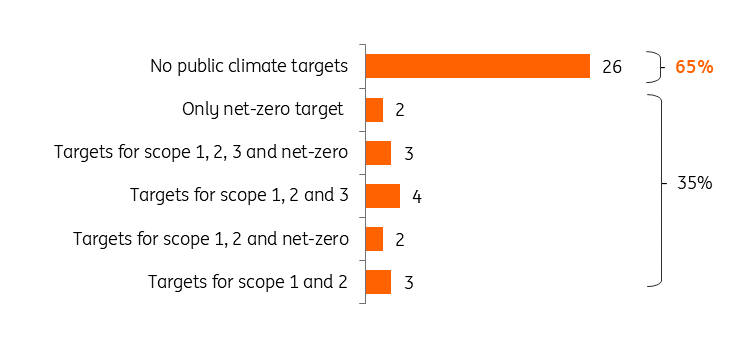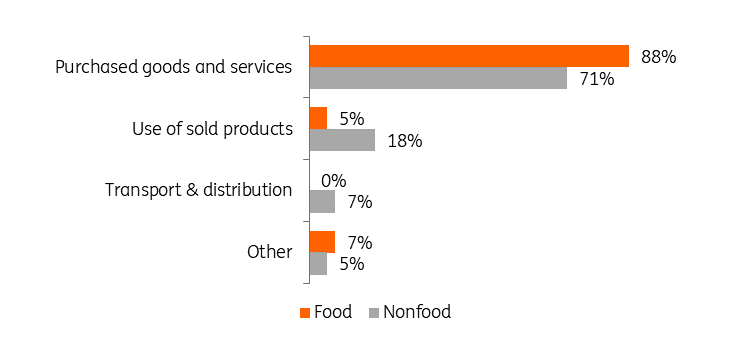A Slow Start To The Climate Transition For The Dutch Retail Sector

Image Source: Pixabay
Just one-third of the largest Dutch retail chains have published concrete climate targets. To reduce CO2 emissions, retailers are now implementing energy-saving measures in their own activities. But ultimately, the retail sector must evolve towards a greater balance between sustainability and commerce than we're currently seeing.
Few retail chains have published concrete climate goals
The retail sector, just like other sectors, now faces the challenge of significantly reducing greenhouse gas emissions in the coming years in order to achieve the climate goals set by the Netherlands. An inventory by ING Research among the 40 largest Dutch retail formulas (with at least 100 branches in the Netherlands) shows that a majority have not yet published concrete climate targets. Some of these companies may already be formulating climate objectives – but they are still in the early stages and do not yet want to share this publicly for various reasons.
Approximately two-thirds of the largest Dutch retail chains have no publicly published climate objectives
Number of the largest Dutch retail formulas according to the climate goals that they have published online

Source: Locatus, websites retail chains, ING Research
Direct CO2 emissions in retail are relatively low
Three flows can be distinguished within the value chain that causes greenhouse gas emissions. Scopes 1 and 2 cover the emissions of their own operations, such as gas consumption and the purchase of electricity from third parties for the shops and the head office. Scope 3 covers emissions by third parties in the value chain (upstream and downstream) such as the purchase of products, transport, and use of products by consumers. The retail companies themselves have relatively low CO2 emissions. The Scope 1 and 2 emissions of the 40 retail chains examined represent on average 2% to 10% of the total emissions, depending on the segment in which a retailer is active. Approximately 90% to 98% of CO2 emissions occur in the value chain, both with producers and other suppliers and with the consumer.
The largest CO2 emissions in retail concern the purchase and sale of products
Share in indirect emissions from the retail chain (Scope 3)

Source: online sustainability reports from Dutch retail chains, ING Research
Net zero most challenging objective
Of the 40 largest Dutch retail chains, 14 companies have publicly published climate objectives. Of these, half have a net zero target. This means that they strive to reduce greenhouse gas emissions throughout the entire value chain (Scopes 1, 2, and 3), in this case between 2030 and 2050 and by as much as possible (90% to 95%). The rest – i.e., unavoidable CO2 emissions – are captured and then stored to prevent them from entering the atmosphere. Achieving net zero is a major challenge for all companies and is the most far-reaching because it concerns all emissions from the entire value chain. Only 17% of the 40 major retail chains dare to make a net zero commitment.
More than halving CO2 emissions by 2030
Companies with concrete climate goals aim for an average of more than half (55%) of CO2 emissions in Scope 1 and 2 by 2030. There are major differences in the set goals, which vary from a reduction of 20% to 78% of CO2 emissions.
Scope 3 emissions still unknown for many retail chains
While the largest CO2 reduction can be achieved elsewhere in the value chain (Scope 3), only seven of the 40 Dutch retail chains analyzed have set concrete public climate goals for Scope 3. This is mainly because most Dutch retail chains do not yet have data on CO2 emissions in Scope 3.
Many companies experience difficulties in identifying Scope 3 emissions
For many companies, it's complicated to gain insight into Scope 3. For example, retail chains need to know where their products come from, who produces them, and what materials are used. Mapping Scope 3 is relatively easier for companies that operate with only a limited amount of products from a number of regular suppliers than it is for companies that purchase many different products from different suppliers around the world.
Greater transparency is needed in the retail value chain
One of the main bottlenecks when mapping Scope 3 is a lack of transparency within the retail value chain. In certain sectors, direct suppliers are often reluctant to communicate transparently with their direct suppliers. This is out of fear that their customers will contact their indirect suppliers directly. To achieve CO2 reduction within the value chain, it is therefore important that there is sufficient support, trust, and cooperation between all parties involved. This ensures the ability to take steps towards greater transparency along the entire value chain.
Regulation is a key driver of the sustainability strategy
The inventory shows that store formulas with concrete climate objectives are often part of listed companies. These are also the first to report on the impact of their business activities on people and the climate from 2025 onwards under the EU's Corporate Sustainability Reporting Directive (CSRD). A year later, however, it is also the turn of other large, unlisted retail formulas to report. Not all of these retail chains have yet published concrete climate objectives. It is expected that they will do so over the next two years, driven in part by legislation and regulation.
Energy-saving measures are especially popular
In order to reduce CO2 emissions, a majority of retail companies have started implementing energy-saving measures in their own buildings (Scope 1 and 2), such as the head office, stores, and distribution centers. The most commonly taken measures include investments in LED lighting, heat pumps, green energy and solar panels. However, the greatest impact of CO2 reduction can be achieved in the value chain (Scope 3). This can be brought about by switching to a more sustainable range, using more reusable or recyclable packaging, opting for more sustainable transport and tempting consumers to make more sustainable choices.
Moving toward sustainable economic growth
It is clear that there is still more work to be done in retail when it comes to the climate transition. To date, the most progress has been made in implementing easily accessible energy-saving measures. But ultimately, retail chains must move towards growth that takes the climate more into account than is currently the case.
While the focus of most companies is now firmly on reducing CO2 emissions (partly due to regulation), other sustainability factors are also important for more sustainable economic growth. Matters such as a fair chain, biodiversity, water use, health, and a safe working environment must ultimately be included in the sustainability policy considerations of retailers.
More By This Author:
FX Daily: Short-Term Rates Argue Against Another Big USD Leg Lower
Asia Morning Bites For Friday, December 1
Deeper OPEC+ Supply Cuts
Disclaimer: This publication has been prepared by the Economic and Financial Analysis Division of ING Bank N.V. (“ING”) solely for information purposes without regard to any ...
more


